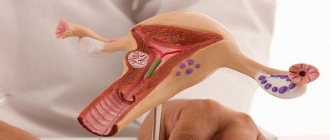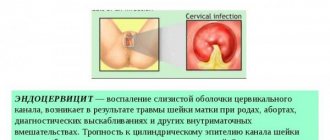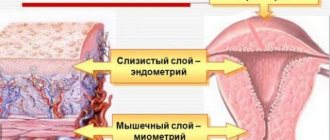Curettage (curettage) is a gynecological operation during which the doctor, using special instruments, removes the mucous membrane - the functional upper layer of the uterine cavity. The procedure is performed for both diagnostic and therapeutic purposes.
The appointment of diagnostic curettage of the uterine cavity is justified if it is necessary to collect material for histological examination. Traditional cavity curettage is practiced to remove altered endometrium, pathological neoplasms, and also when removing the fertilized egg (abortion).
Question: Is it possible to take a bath or shower after hysteroscopy?
The site provides reference information for informational purposes only. Diagnosis and treatment of diseases must be carried out under the supervision of a specialist. All drugs have contraindications. Consultation with a specialist is required!
Can I take a bath or shower after hysteroscopy?
After hysteroscopy, you can only take a shower for 2–4 weeks, and during the same period of time it is prohibited to take a bath. After 2 to 4 weeks after hysteroscopy, a woman can take both a shower and a bath. The specific period of time (2, 3 or 4 weeks) during which it is forbidden to take a bath is determined by the duration of the discharge from the genital tract. That is, if discharge from the genital tract stops 2 weeks after hysteroscopy, then you can take a bath after this period of time. If the discharge continues for 4 weeks, then the bath should not be taken during this time.
The ban on taking a bath after hysteroscopy is due to the high risk of infection of the internal genital organs with various bacteria, which can enter them with the flow of water through the open and dilated cervix after manipulation. Moreover, both opportunistic microorganisms from the vagina and pathogenic bacteria from water that is not sterile or distilled can enter the uterine cavity. After 2 to 4 weeks after hysteroscopy, the cervical canal closes again and does not allow various microorganisms into the uterine cavity, and then taking a bath again becomes a completely safe procedure.
Source
Cleaning a frozen pregnancy with tablets
Instrumental cleansing of the uterus is required in only 10% of women with a regressing pregnancy. If the embryo has stopped developing for up to 6 weeks, then it is more appropriate to clean it with pharmaceuticals. For this purpose, tablets based on mifepristone and misoprostol are often used.
Preparation for cleaning during a frozen pregnancy with tablets:
No special preparation is required. The day before and on the day of cleansing, it is not recommended to consume foods that are difficult to digest and alcohol.
How does cleaning with tablets occur during a frozen pregnancy in the early stages:
- Mifepristone is taken, which promotes the separation of the fertilized egg from the endometrium. While taking the drug, you should not use drugs from the NSAID group and acetylsalicylic acid.
- After 36-48 hours, Misoprostol is drunk, which provokes contractile activity of the uterine walls and expulsion of the conceptus from the uterine cavity. Cramping pain after cleaning a frozen pregnancy with tablets at this stage is normal.
- No later than 10 days after completion of the procedure, an ultrasound is performed to assess the effectiveness of cleaning with tablets.
Pros:
- no need for anesthesia;
- no mechanical impact on the cervix and uterine cavity;
- lower risk of complications.
Minuses:
- high cost;
- soreness;
- in 3-5 women out of 100, the pills do not work completely;
- complications may develop.
What not to do after curettage of the uterus
What do doctors forbid doing after cleaning (curettage) of the uterus and why? The answer to this question will be relevant for all women who have undergone or are preparing for this gynecological procedure.
For several hours after curettage of the uterus, the woman experiences severe bleeding. It is possible that discharge may appear in the form of clots. This cannot be avoided, since it is the body’s physiological response to the injury received during cleansing.
A few hours after curettage, the discharge becomes less abundant, but it can last up to 14 days.
What should you not do during this period? Gynecologists give standard recommendations for the next two postoperative weeks.
- use of sanitary tampons - only pads are allowed;
- sexual intercourse (including with a condom);
- visiting a bathhouse and sauna, swimming in a bathtub with immersion in water;
- performing douching (irrigation of the vagina);
- taking medications containing acetylsalicylic acid without a doctor’s prescription;
- engage in hard work, do exercises, giving the body significant physical activity.
How to speed up the healing process after cleansing
To do this, you need to follow all the doctor’s recommendations. Adviсe:
- keep your genitals clean; take a warm shower twice a day; You cannot wash in a bath, bathhouse, or sauna;
- douching should not be done, all cleansing procedures must be superficial;
- change pads as they fill, but at least 6-8 times a day; in the first days it is better to use diapers (the same as after childbirth);
- even with small discharge, do not use vaginal tampons - this interferes with cleansing;
- any physical activity and tension should be avoided in the first two weeks after cleansing;
- sexual intercourse is possible only after the complete cessation of lochia.
If cleansing after childbirth is successfully carried out and all necessary requirements are met in the postoperative period, as a rule, there are no negative consequences for women. Much more serious consequences occur if cleaning was not carried out in a timely manner.
Hygienic tampons
After curettage of the uterus, the woman begins to bleed. This is a physiological process, since cleaning the organ is accompanied by injury to the mucous layer lining it. The discharge is reminiscent of menstruation in its strength and character. But what you can’t do after scraping is use hygienic tampons.
All kinds of this hygiene product can be found in all pharmacies. The advantages of tampons over sanitary pads are obvious, but they only apply to menstruation and only to healthy women.
After curettage of the uterus, the type of bleeding is completely different: pieces of exfoliated mucous come out along with the blood. They should not linger inside the vagina. Do not forget that tampons only absorb liquid secretions. The clots will remain inside.
There are other explanations for this. Blood flowing from the uterus and vagina becomes an excellent breeding ground for pathological microorganisms. Tampons cannot be used because they will interfere with the free flow of secretions. Thanks to this, ideal conditions are created inside the vagina for infection of the injured uterus - the likelihood of developing an inflammatory process increases significantly.
Using tampons after curettage can lead to infection, fever, and increased pain that accompanies uterine cleansing.
The ban on using tampons during the recovery period after cleaning is also explained by the composition of the product. It definitely contains dioxin. The product helps make tampons white because it acts as a bleach.
Dioxin is extremely dangerous for the female body. It is very toxic, capable of reducing local immune defense, and also negatively affects the state of the reproductive system as a whole. In addition, dioxin can trigger the development of toxic shock syndrome in sensitive individuals.
Traditional methods of cleaning the uterus after childbirth
You can speed up the recovery of the female reproductive organ with the help of herbs that help stabilize hormonal levels and contractions of the uterus. The action of such herbs stimulates muscle tone and improves immunity.
Drinks that help cleanse the uterus include:
- nettle infusion. Nettle is very popular as a folk remedy due to its availability. To prepare the infusion, add 5 tablespoons of dry nettle to 500 ml of boiling water and let it brew until cool. You can drink half a glass of liquid up to 3-4 times a day. Nettle promotes uterine contractions and also has an anti-inflammatory effect;
Nettle infusion has an anti-inflammatory effect
Viburnum juice is not recommended for future use, but should be consumed immediately after preparation.
In addition to herbs, the following help tone the uterus and remove clots:
- moderate physical activity;
- frequent emptying of the bladder.
Sexual relations
Sexual contact is the next thing you should not do after cleaning the uterus. The duration of abstinence is determined by the gynecologist individually in each case after examining the patient. The duration of uterine recovery depends on the cause of curettage and the general health of the woman. In the vast majority of cases, the recovery period lasts 1 menstrual cycle.
You can have sex after curettage no earlier than 2 weeks later. This is the minimum period during which the uterine mucosa is completely replaced after cleaning. It is advisable to use a condom and avoid casual sexual intercourse.
If the endometrium has not yet fully recovered, the risk of infection increases significantly. There are many diseases that occur in a latent form and do not pose a danger to a healthy body. But as a result of weakened immune defenses, the likelihood of infection and the spread of the disease increases significantly.
There is also a risk of damage to the vaginal walls, which can increase the severity of bleeding. And this is another reason why you should not have sex after cleansing.
After the start of sexual activity, a woman may feel slight pain, burning and dryness in the vagina. There is no need to do anything, since such symptoms are considered normal and go away on their own.
If the discomfort does not go away, then you need to consult a gynecologist. After a vaginal examination and based on the results of a transvaginal ultrasound examination, appropriate treatment will be prescribed.
Reviews from women who have undergone uterine cleansing
I had a cleanse right after giving birth. The afterbirth came out all torn and pieces remained inside. They did it without anesthesia. I didn't feel any pain at all. A week later there was an ultrasound and everything was clear. By the way, the sick leave was extended by 2 weeks because of this. Subsequently, there were no problems. Then she gave birth to a daughter 2.5 years later. The afterbirth was intact, they did nothing.
kia85
https://www.babyplan.ru/forums/topic/46372-chistka-polosti-matki-posle-rodov/page__pid__10019956#entry10019956
Under the general one you won’t feel anything, there was a general one, they did the cleaning, I woke up with ice on my stomach, I didn’t feel any sensations when the anesthesia wore off and the ice was removed, I just felt discomfort like during my period.
I am cheerful and cheerful
https://deti.mail.ru/forum/v_ozhidanii_chuda/rody/chistka_posle_rodov_komu_delali/
I had this happen after giving birth. The placenta was removed by hand when a cesarean section was performed. On days 6-7, the doctor somehow determined by the nature of the discharge and the size of the uterus that there were pieces of the placenta; an ultrasound confirmed a piece of 9 mm. On the same day, they did the cleaning under general anesthesia, it didn’t take long, just 5 minutes + 5 minutes to wake up. I didn’t feel anything, everything went quickly and I quickly recovered from the anesthesia. But all these procedures were done to me right in the maternity hospital. Don't be afraid of anything, everything will be ok! The main thing is to do everything on time.
podarochek
https://puzyaka.ru/forum/showthread.php?t=16064
After the first birth, I bled for almost 2.5 months, then when I went to the doctor, they sent me for an ultrasound. The result is the remainder of the placenta and cleaning under general anesthesia. During G.’s second birth, a doctor friend examined the placenta millimeter by millimeter and, squeezing it out of the uterus as much as possible, thought that everything…………. However, the ultrasound showed that there was something left there again………… The verdict was cleaning again……… But first she gave me pills, maybe it will come out on its own………… It didn’t work out, when I came to the appointment after examining her, bleeding began (with for 3 days the gasket was completely clean), I had to do an urgent cleaning under local anesthesia (icecaine), then 2 hours under a drip and driving and home………. The result is a special structure of the uterus (loose) and the ability to retain pieces………
Irishka0880
https://puzyaka.ru/forum/showthread.php?t=16064
It doesn't hurt. I was also afraid, they warned me that there would be no anesthesia, since my uterus had just given birth (I had a CS). The sounds are a little unpleasant. I quietly materialized, but then apologized) I had to go on a gurney, IVs and lie down for half a day. I was more worried.
Henrietta_neither this nor that
https://www.woman.ru/health/woman-health/thread/4744299/
Don't be afraid of cleaning your uterus. When prescribed by a doctor, you must undergo this procedure. If there are not very many clots in the uterus and they come out on their own, you can implement a number of measures to stimulate the activity of the uterus and its cleansing. Using traditional methods or undergoing a cleansing procedure, you will get rid of the risk of complications and in the future you will be able to plan a new pregnancy without any problems.
Bath and sauna
The next thing you should not do after curettage of the uterus is to visit a bathhouse or sauna.
Until the discharge completely stops, you can only take a warm shower. Why can’t you go to a hot bath after cleansing? The answer to the question lies in physiology. The uterus, injured by curettage, bleeds heavily, which explains the bleeding that accompanies the procedure.
Sudden changes in temperature - a cool waiting room and a hot bath room - can cause additional blood flow to the organ damaged by the procedure. This causes increased discharge, leading to the development of serious bleeding requiring medical attention.
What else can't you do? After scraping, saunas are also prohibited. As a rule, these are public areas. After cleansing, a woman’s body is especially susceptible to various types of infections: an open cervix and injured mucous membrane greatly simplify the process of penetration of pathological bacteria to the wound surface. It is not possible to ensure the sterility of wooden surfaces (benches, benches and deck chairs), and in warm and humid conditions, pathogenic bacteria multiply very quickly.
If visiting a bath or sauna after cleaning the uterus cannot be avoided, then the following rules must be followed:
- the maximum time spent in the bath (not too hot) is 25 minutes;
- time spent in the steam room/sauna (at a temperature not exceeding 70° C) – 10 minutes;
- It is not recommended to remove underwear.
Vacuum cleaning of frozen pregnancy
Cleansing the uterus from concept products using vacuum aspiration is the most gentle instrumental method. It is carried out no later than 7 weeks of gestation in cases where cleaning with tablets was not completed completely or is impossible due to the advanced stage of pregnancy or the patient’s reluctance.
Preparing for vacuum cleaning of a frozen pregnancy:
The procedure can be performed under either general or local anesthesia. The choice of anesthesia affects preparation for the procedure.
- If general anesthesia is to be performed, the patient should completely abstain from eating and drinking 8-12 hours before vacuum aspiration.
- If cleaning will be carried out under local anesthesia, then half an hour before the procedure the patient should take one of the drugs that relaxes the cervix and reduces pain. Prolonged fasting is not required.
- Before vacuum aspiration, all vegetation in the bikini area must be removed.
- At least a few days before aspiration, you must stop having intercourse, using hygienic intimate cosmetics, and taking medications.
How to do vacuum cleaning during a frozen pregnancy:
- The patient undresses below the waist and lies down on a special couch or chair.
- The external genitalia are treated with an antiseptic solution.
- A speculum is inserted into the vagina.
- The cervix is opened slightly and a hysteroscope is inserted through it to determine the length of the uterus.
- After removing the hysteroscope, an aspiration tube connected to an electric or manual aspirator is inserted into the uterine cavity.
- The conceptus is removed.
- Aspiration can be done by touch or under ultrasound monitoring.
- After vacuum cleaning, it is recommended to lie on your stomach for half an hour or an hour under the supervision of specialists.
Pros:
- no significant trauma to the uterus;
- the ability to do without general anesthesia.
Minuses:
- incomplete abortion is possible;
- complications may develop.
Douching
The cervix is normally closed, but after cleaning it remains open. Thanks to this, its cavity is cleansed and blood clots are released unhindered. And it is at this moment that the organ is especially vulnerable to various pathogenic microflora.
During the recovery period after curettage, no vaginal irrigation should be done. Douching is permissible only in exceptional cases. They can only be done on an outpatient basis or as prescribed by a doctor.
The walls of the organ after curettage represent a wound and if an irrigating liquid containing aggressive components gets on its surface, a chemical burn may occur. Such lesions require long-term and complex treatment, so douching after cleaning is prohibited.
How to avoid uterine cleansing after childbirth
When I was in the hospital, I was advised to go to the toilet frequently to urinate and do reasonable exercise to stimulate the passage of clots. To activate uterine contractions, an oxytocin drip was given. After discharge, she was prescribed to take a course of pepper water extract (knotweed), which increases the tone of the uterus, stimulating its contractions. I took 30 drops orally 4 times a day 30 minutes before meals. The course of treatment was 5–7 days.
The release of blood clots after childbirth is normal and even necessary. However, if there are few clots or, according to the results of an ultrasound, the woman has seen stagnation of blood clots, you can perform certain actions that promote the release of excess blood and help, in some cases, to avoid cleansing the uterus:
- apply cold or ice to your stomach;
- Breastfeed your baby more often and for longer. This promotes the production of the hormone oxytocin, which leads to uterine contractions;
- move actively, perform acceptable physical exercises allowed for new mothers;
- lie on your stomach;
- Empty your bladder more often.
After a cesarean section, there may also be problems with removing blood clots from the uterus, since:
- physical activity is contraindicated;
- Breast milk may come in slowly.
Therefore, young mothers who have had a CS are prescribed injections or drips of oxytocin while still in the maternity hospital.
Physical exercise
After cleaning the uterus, you should also not do exercises or physically strain yourself in any other way.
Light exercise can be performed after bleeding has stopped, and regular exercise can be resumed after 1 menstrual cycle.
Significant loads after curettage can only increase pain and activate discharge, increasing its volume. As a result, there is a high probability of large blood loss.
The gynecologist who performed the procedure should tell the woman what can and cannot be done after cleaning the uterus. To avoid postoperative complications, all recommendations must be followed especially strictly.
Source
Pregnancy after curettage, is it possible to get pregnant immediately and after a month after cleaning?
According to statistics, after curettage, pregnancy can occur in the same cycle. However, the forecasts for such gestation will be disappointing. It happens that the body is not ready to perform new tasks, since it has not yet had time to recover from the operation. If a woman has undergone curettage, the doctor gives individual recommendations for the recovery period and further pregnancy planning.
Why and how is curettage done?
In common parlance, scraping or cleaning is the procedure for cleansing the cavity of the reproductive organ using special instruments. Uterine curettage is performed for diagnostic or therapeutic purposes.
The main task of surgical manipulation is to free the uterus from the functional layer and obtain biomaterial for further research.
The uterine cavity is scraped according to the following indications:
- removal of a frozen pregnancy or remains of a fertilized egg after a spontaneous abortion;
- prolonged bleeding after a miscarriage;
- excessive thickening of the endometrial layer – hyperplasia;
- inflammatory process in the functional segment of the uterus - endometritis;
- suspicion of cancer due to uterine fibroids or other neoplasms;
- bleeding after menopause;
- irregular menstruation;
- infertility of unknown origin.
The technique for performing curettage for any indication is the same. It is performed under general or local anesthesia. The choice depends on the complexity of surgical treatment and the scale of the problem. After this, the external genitalia are treated with an antiseptic solution, the cervix is dilated and curettage is performed. The duration of the procedure is variable, but usually it does not exceed 40-60 minutes.
How to recover after curettage?
After cleansing, a woman needs time to fully restore her body in order to become pregnant. Good health can return quite quickly, but this does not mean that all functions are performed according to the usual pattern.
In most cases, after surgery, the patient is prescribed antimicrobial therapy to prevent the development of complications.
If the curettage procedure was therapeutic, then a number of tests are performed to help determine the cause of the problem:
- testing for infections;
- determination of hormonal levels;
- histological analysis of the obtained biomaterial;
- Ultrasound of the pelvic cavity.
Based on the results obtained, the gynecologist may recommend that the woman take additional hormones, antibiotics, anti-inflammatory and restorative agents. In order for the body to “come to its senses”, it is necessary to strictly follow the recommendations.
After cleaning, you can get pregnant no earlier than six months later. This temporary limitation is given to most patients. For some women, the period increases to 9-12 months. If large-scale treatment with hormonal drugs is required, the period is even longer.
For 2-3 weeks after curettage, the patient should avoid sexual intercourse. During this period, the mucous membrane is vulnerable to various kinds of microorganisms. Unprotected sex can cause infection.
For a speedy recovery, you need to avoid swimming in public ponds and hot baths, avoid sunlight and do not sunbathe in a solarium, do not douche or use tampons.
For 7-10 days, the patient is recommended to reduce physical activity and not lift heavy objects.
If bleeding after curettage continues for more than 7 days or acquires an unpleasant odor, and there is also an increase in temperature, accompanied by acute abdominal pain, then you should definitely consult a doctor. Too rapid cessation of blood discharge (1-2 days) also requires observation by a gynecologist.
When to plan pregnancy after cleansing?
It is impossible to say for all women at once when it is permissible to start planning a pregnancy after curettage. Much will depend on what prompted the operation. If the cleansing was performed for diagnostic purposes to study possible causes of infertility, then you can start conceiving already in the next cycle.
This month it is better to avoid open sexual intercourse to avoid infection. The woman is also advised to wait for the results of a histological examination, which may show the need for additional treatment. If no problems are found in the uterine cavity, then pregnancy after cleaning can be planned immediately.
A patient who has had a frozen pregnancy or spontaneous abortion wants to get pregnant quickly. Such a desire is quite natural, but one cannot rush. First, it is necessary to establish the cause of the unsuccessful pregnancy and eliminate it.
This will take from 3 to 6 months. A woman cannot become pregnant immediately after cleansing, since her body has not yet fully recovered.
Hormonal levels will return to normal in 1-2 months, but the uterus may not be ready to receive a fetus for up to a year.
The average recommended period for abstinence from conception is 6-12 months.
It’s better not to rush into planning a new pregnancy
Is it possible to get pregnant after curettage?
You can get pregnant after cleaning the uterus. Correctly performed surgery does not cause infertility. If a woman previously had difficulties conceiving, they usually remain after curettage. Without preliminary treatment it will be difficult to get pregnant.
It is a mistake to believe that pregnancy cannot occur quickly after cleansing. Conception can happen as soon as hormonal levels are restored. This usually does not take more than three months. Regular menstruation and stable cycles will be evidence of the proper functioning of the gonads.
As soon as the body turns on the reproductive function, the ovaries will begin to produce follicles with eggs, and the functional layer of the uterus will mature. Pregnancy after endometrial curettage can occur next month. There are cases where ovulation occurred within 2-3 weeks after surgery, and as a result of unprotected contact a fertilized egg was formed.
A woman has a greater chance of conceiving quickly if curettage was performed for an uncompleted miscarriage or for the purpose of terminating a pregnancy.
The body of such patients usually does not have additional obstacles to fertilization.
Pregnancy after hysteroscopy with diagnostic curettage can also occur, but usually this does not happen so quickly, since there are additional problems in the body that prevent fertilization.
Is it dangerous to accidentally conceive immediately after cleansing?
Medicine knows cases where the patient immediately became pregnant after cleaning. The prognosis for such gestation may be disappointing. Repeated scraping after such a short period of time is dangerous. Therefore, depending on the individual characteristics of the organism, the appropriate tactics of action are selected.
If you manage to get pregnant after cleaning earlier than 3 months, you should immediately seek help from a gynecologist.
Such patients usually require maintenance therapy, since the production of their own progesterone is insufficient. Often pregnancy is complicated by the threat of miscarriage in the early stages and placenta previa in the later stages.
The cause of such problems is the failure of the endometrium, which has not had time to recover fully.
Due to the high probability of infection after curettage, the patient is prescribed antibiotics and antiprotozoal drugs. Their use is usually incompatible with pregnancy.
If a woman does not yet know that she is pregnant and uses such medications, then they can affect the process of fetal formation, having a teratogenic effect.
This is why it is so important to protect yourself in the first few months.
The psychological factor plays an important role. If a woman gets pregnant immediately after a curettage performed for a spontaneous abortion, she will be afraid of a repeat of the situation. Additional emotional experiences negatively affect the course of pregnancy.
Infertility after curettage
Getting pregnant after curettage can be difficult for women who have additional obstacles: hormonal imbalance, polycystic ovaries, endometrial hypoplasia. If cleansing was carried out to identify the causes of infertility, it usually does not increase the likelihood of conception in the future. It will be difficult for patients belonging to these groups to become pregnant after curettage.
If injuries were sustained during the operation or an inflammatory process developed after treatment, then conception is also unlikely. It will not be possible to get pregnant after curettage if:
- During surgery, the rules of asepsis were violated, which caused endometritis;
- there was a puncture of the uterine wall - perforation (a complication requires laparotomy followed by long-term treatment);
- damage to the germinal layer of the reproductive organ occurred;
- the myometrium was injured;
- Ovarian dysfunction occurred.
IVF after hysteroscopy with curettage can be performed in the next cycle. It is important to choose a suitable program for the patient so that the hormonal levels are completely controlled by fertility doctors.
Source: https://MyZachatie.ru/zhenskie-zabolevaniya/beremennost-posle-vyskablivaniya.html
When to expect menstruation after curettage
If curettage does not produce any complications or unexpected consequences, menstruation may occur within 4–5 weeks. The beginning of the cycle is counted from the date of curettage.
But even doctors are not able to say when exactly your period will start after curettage. Everything will depend on the female body’s ability to recover and the reasons for the operation. Minor delays and premature bleeding are allowed. Normally, these deviations do not exceed 3–5 days.
The maximum permissible period of absence of menstrual flow is two weeks. The exception is abortion and miscarriage. After them, the cycle can take a long time to recover and the first menstruation after a miscarriage or abortion will be delayed by 1-2 months.
The second, third and subsequent menstrual bleeding occurs on time. If the cycle disturbance continues to bother the woman, then it is necessary to conduct additional diagnostics and tests. The following may cause a failure:
- external negative factors;
- consequences of scraping;
- new diseases;
- violation of gynecologist's instructions.
The doctor can guess when your period will start after cleaning the uterus. The specialist takes into account the nature of the pathology, the general health of the patient and the specifics of the intervention. The date is calculated approximately, since a deviation of several days is allowed for any woman, regardless of surgical intervention.
Scraping process
The procedure is performed under anesthesia, so the patient will not feel any pain or discomfort. The best period for cleansing is a few days before the start of menstruation. At the moment, the body is ready to replace the mucous layer of the cavity, due to which curettage will not bring an overall negative effect on the uterus. But the timing of curettage remains dependent on the diagnosis, so the attending physician may prescribe surgery at the beginning of the cycle.
Currently, there are two main ways of carrying out the procedure.
- Curettage without video surveillance. In this case, the endometrium is collected blindly with a specialized instrument - a curette. After the uterine cavity is expanded, an instrument is inserted and cleaning is performed. The obtained material is subjected to histological diagnosis. The woman is prescribed treatment after cleansing in such a way as to prevent recurrence of the disease and infection of the uterus. If curettage was performed for the purpose of terminating a pregnancy, then endometrial histology after manipulation is usually not performed. The exception is a non-developing pregnancy.
- Cleaning with hysteroscopic method. The essence of the method is almost identical to the previous one, but in addition to the main instrument, an optical device is also used - a hysteroscope. Initially, the uterine cavity is filled with liquid or gas, with the help of which it expands. Many gynecologists are inclined towards this technique, since it is more accurate, reduces the risk of injury and increases diagnostic value.
Nature and quantity of discharge
The first periods after curettage come according to the usual schedule and have the same characteristics:
- natural shade;
- normal amount;
- usual duration;
- minor pain.
Modification of monthly bleeding is allowed only for the better. After all, the purpose of cleaning or scraping is aimed at eliminating disorders of the reproductive system. Therefore, women who are accustomed to heavy or long periods mistake positive changes in the cycle for pathology.
Menstrual flow as a result of curettage can:
- maintain your usual volume;
- become meager;
- increase your number;
- develop into bleeding.
In a normal situation, the change in the amount of discharge is positive due to the elimination of a negative factor (disease). You should be alarmed by spotting on the pad or heavy bleeding.
Curettage procedure after miscarriage
The manipulation takes 15–20 minutes. A preliminary referral is given for a coagulogram and general blood tests, testing for infections. Cleaning after an early miscarriage (up to 12 weeks) is carried out if, according to ultrasound, fragments of the fertilized egg are detected in the uterus.
You should not take food or liquid 8–10 hours before surgery. The curettage procedure takes place on a gynecological chair: the genitals are disinfected with an antiseptic, the cervix is dilated and the mucous layer is scraped out with a vacuum or curette. These manipulations are quite painful and are performed under anesthesia - local or general. If possible, hysteroscopy (examination with a video camera) is performed simultaneously with curettage: curettage after a miscarriage is considered the least dangerous when the doctor sees the uterine cavity.
If there is an early miscarriage, the embryo may come out entirely (it looks like a gray round bubble), then cleaning is not required. In other cases, fragments of the fetus will begin to decompose, which will give rise to the spread of pathogenic microbes and damage to the lining of the uterus. Therefore, even if a miscarriage occurs outside a medical facility, and the woman is sure that the embryo has been released completely, you should not neglect a visit to the doctor.
Cycle after diagnostic curettage
The easiest way is to determine when your period will come after a diagnostic curettage. Minimal tissue trauma and quick recovery times have virtually no effect on the cycle.
You need to pay attention to the reason for diagnostic curettage:
- uterine bleeding;
- failure of the menstrual cycle;
- cycle without ovulation;
- suspicion of endometrial neoplasm;
- other violations.
Problems with menstruation may arise if the following pathologies were confirmed during diagnosis:
- polyp of the endometrium or cervical canal;
- proliferation and thickening of endometrial tissue;
- cancer diseases;
- endometritis;
- endometriosis;
- benign formation in the uterus;
- pathology of the cervix.
Consequences of cleaning the uterus
If the doctor has prescribed cleaning of the uterus, then undergoing the procedure is mandatory, since complications will occur not because of the cleaning, but because of the refusal to undergo it. After the operation, the endometrium (inner mucous membrane of the uterine body) will gradually recover. The uterus will be covered with a new healthy layer of epithelium.
However, the consequences of cleaning the uterus cannot be completely excluded. In some cases, the following may occur:
- uterine bleeding. This phenomenon occurs rarely after cleaning. It usually affects women who have previously had problems with blood clotting;
- hematometers - retention of liquid blood or blood clots in the genitals. This pathology after cleansing is quite rare and occurs due to severe compression or spasms of the muscles of the cervix or vagina. To avoid hematomas, obstetricians-gynecologists can prescribe Aspirin or No-shpu. These drugs help relieve muscle spasm, ensuring free cleansing of the female genital organ;
- endometritis - inflammation of the inner layer of the uterus. It can occur due to the penetration of bacteria and microbes into the wounded surface of the uterus. To exclude the occurrence of endometritis, it is necessary to take a course of antibiotics.
With proper and delicate cleaning, the risk of negative consequences after the procedure is reduced to zero. Therefore, you should not be afraid of the operation and its consequences. Agree to medical intervention.
Menstruation after an abortion or frozen pregnancy
After abortive curettage, menstruation may begin within a few months. A similar situation arises when eliminating a frozen pregnancy. The female body needs more time to recover due to severe stress and hormonal imbalance.
When your period starts after an abortion depends on the method of the operation. Blind curettage is fraught with severe tissue damage or incomplete removal of the embryo. Therefore, recovery of the body may take longer. Vacuum abortion is safer for women.
Delayed menstruation or bleeding after curettage (abortion, miscarriage) can be caused by several factors:
Hormonal disbalance
The female body begins to suffer from restructuring, even if conception did not end with the birth of a child. The gynecologist may also prescribe hormonal oral contraceptives to prevent pregnancy during the recovery period.
Non-compliance with recommendations
It is necessary to take care of your health. Any violation of the doctor’s instructions can cause inflammation, infection and other negative factors that cause menstruation to be delayed.
Poor cleaning
If during the intervention the specialist left fetal particles in the uterine cavity, then severe bleeding and cycle disruption cannot be ruled out. That is why such procedures need to be carried out with modern instruments that allow you to control the entire process so that particles of the fertilized egg or placenta do not remain inside.
Indications for surgery
Curettage is performed only as prescribed by the attending physician for the diagnosis or treatment of certain gynecological diseases.
Indications for curettage of the uterine cavity.
- Visual changes in the structure of the endometrium that were detected on ultrasound. Cleaning for hyperplasia and other similar disorders can be carried out for diagnosis. Thus, the material necessary for the examination is collected.
- Uterine polyps were discovered. If cleaning is carried out correctly, polyps are eliminated along with the mucous layer, and if further treatment after cleaning is carried out correctly, then there is a guarantee that such a nuisance will no longer bother you.
- Long-term menstrual irregularities.
- Menstruation has been profuse for a long time.
- Bloody discharge not during menstruation.
- Prolonged absence of pregnancy without established reasons.
- Bleeding during menopause.
- Suspicion of malignant formations in the cervix.
- Curettage of the uterine cavity and treatment after curettage are simply necessary in case of miscarriage or premature birth. In this way, you can completely remove the remaining placenta from the cavity if this does not happen naturally.
- Inferior development or arrest of pregnancy. If the development of the embryo stops, curettage in this case is necessary to remove the fertilized egg. In this way, inflammatory processes can be avoided.
- Cleaning after delivery in case of presence of placenta residues in the uterus.
- Curettage during abortion.
- Suspicion of endometriosis.
- Intrauterine adhesions.
Cleaning can be carried out before planned gynecological operations for diagnostic purposes, for example, when removing fibroids or ovarian cysts.
Menstruation after endometrial cleansing
When, after cleaning the endometrium with hyperplasia, menstruation begins, largely depends on the experience of the doctor who performed the curettage. In a normal situation, menstrual flow begins no earlier than a month after the intervention.
The delay is most often caused by:
- Deep impact. During the operation, only the functional layer of the mucosa is removed. If the doctor also touched the basal layer, there is a possibility of prolonged recovery and absence of menstruation.
- Hormonal therapy. For hyperplasia, hormones are prescribed that control the functioning of the ovaries. While taking medications that reduce estrogen synthesis, you should not expect menstrual periods. They will begin when the gynecologist cancels the therapy.
- Other factors. A delay can be caused by stress, taking antibiotics, the disease itself, or non-compliance with recommendations. Complications cannot be excluded, which will be signaled by a prolonged absence of menstrual flow.
Knowing when menstruation will begin after cleaning the uterus, and why cycle disruptions may occur, it is easier for a woman to monitor changes in the reproductive system. If the delay does not disappear after stopping hormonal pills, then you need to go to the hospital. After all, hyperplasia is an insidious disease, at the last stage of which even the uterus is removed.
Treatment procedures for relapse
In this case, if after the procedure the endometrium still continues to grow, it is necessary to make a radical decision (often this is a repeat operation). A specialist can say what measures will be taken, referring to individual indicators and other factors.
The first relapse may occur due to improperly performed curettage. This happens due to the fault of the doctor, and also when a hysteroscope was not used during the operation.
If a woman is not interested in further pregnancy, then it is possible to prescribe repeated cleaning of the uterine cavity, during which the mucous membrane with the germ layer will be completely removed.
If there are additional gynecological diseases that can negatively affect the condition and health of the woman (malignant neoplasms), the uterus and appendages can be removed. As for recovery and treatment, in this situation it will be long and very difficult; most often a course of hormone replacement therapy is prescribed, which the woman will have to endure throughout her life.
Disorders after surgery
The following menstruation is a reason to go to the hospital:
- too abundant;
- scanty;
- with an unpleasant odor;
- no discharge.
Heavy periods
The appearance of heavy periods after curettage indicates complications.
Heavy bleeding (one pad is not enough for an hour) can be caused by:
- uterine atony;
- incomplete curettage;
- the remainder of parts of the placenta or fertilized egg;
- endometrial detachment;
- uterine perforation;
- uterine tear.
The main symptoms are decreased performance, fatigue, dizziness, pale skin and low blood pressure.
No discharge
When there is no menstruation after curettage, the reasons may be as follows:
- Onset of pregnancy. Even after such an intervention, conception is possible. Doctors advise avoiding sex until the body recovers and then using contraception.
- Damage to the mucous membrane. A damaged endometrial layer is one of the most dangerous complications. The uterine lining does not regenerate, which is why menstruation does not last for a very long time.
- The occurrence of inflammation. After curettage it is necessary to take antibiotics. The absence of these medications causes inflammatory processes, discharge with an unpleasant odor, high body temperature, and retention.
- Formation of hematometra. Due to cervical spasm or scarring, menstrual blood accumulates in the uterine cavity. Therefore, doctors often prescribe antispasmodics to patients to prevent such a complication.
A woman needs to know how many weeks after cleansing her period begins. A long delay is not the norm, so if alarming symptoms appear, you should consult a doctor and not self-medicate or read the forum. Only in this case will it be possible to avoid complications and serious problems with the reproductive organs.
Source
Treatment after the procedure
The main task after even a minor gynecological operation is to prevent the development of internal inflammatory processes and receive full treatment. It is for this purpose that experienced specialists are required to prescribe an appropriate course of antibiotics. If everything is treated correctly, then cases of inflammation can be avoided. In addition to antibiotics, there are also additional necessary steps of therapy after cleansing.
- Complete saturation of the body with missing microelements: vitamins B, C, A, E, polyunsaturated fatty acids. Thus, the mucous layer after curettage is restored much faster.
- Hormonal drugs. With their help, you can restore hormonal balance in the body and prevent recurrence of the disease.
- Taking a course of reflexology and electrophoresis.
In addition to all of the above, it is necessary to include in the course of treatment drugs aimed at preventing the formation of adhesions (enzymes).
You should undergo regular examination by a gynecologist (this condition is also mandatory after the operation). After completing full treatment, it is necessary to re-sample the mucous layer from the uterine cavity by biopsy to diagnose and exclude the possibility of relapse.











